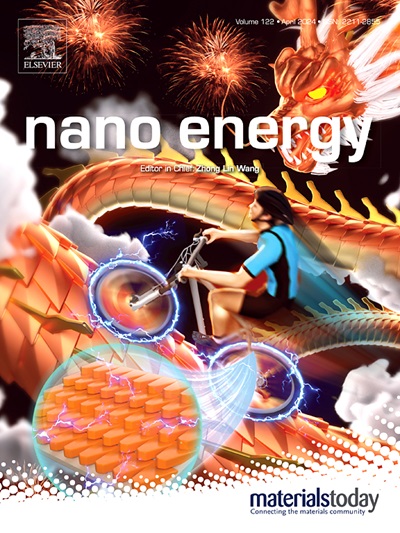纳米结构单晶 TiNb2O7 中的 Fe3+ 体系掺杂用于超快充电阳极的长稳定循环
IF 16.8
1区 材料科学
Q1 CHEMISTRY, PHYSICAL
引用次数: 0
摘要
铌酸钛(TiNb2O7,TNO)已成为快速充电应用中一种前景广阔的锂离子电池(LIB)负极选择。然而,TNO 在极快速充电条件下的循环耐久性仍然有限,相应的结构改变机制也仍不清楚。这项研究报告了一种通过在单晶 TNO 纳米结构中进行铁置换而实现长期循环稳定性的超快速充电阳极。通过理论建模和实验表征相结合的方法,揭示了铁取代对 TNO 的电子特性、离子扩散动力学和结构稳定性产生影响的内在机制。最佳的掺杂 Fe3+ 的 TNO 单晶材料(Fe0.05Ti0.95Nb2O6.975)(Fe5-TNO)在 10 C(仅 6 分钟充电时间)极端快速充电协议(结合 1 C 放电)下可提供 238 mAh/g 的显著充电容量,在 5 C 下可提供 200 mAh/g 的高容量,1000 次循环后的循环保持率高达 85%。我们的计算表明,Fe3+ 置换掺杂导致带隙降低,同时降低了 Li+ 扩散能垒。总之,这些因素有助于减少容量衰减和极速充电,共同促进了适合锂离子电池使用的持久循环性能。反射电子能量损失光谱(REELS)显示,Fe3+ 的掺杂使带隙从 TNO 的 3.75 eV 缩小到了 Fe5-TNO 的约 3.40 eV;在初始锂化之后,TNO 和 Fe3+ 掺杂的 TNO 都转变成了导电率更高的相,这与密度泛函理论(DFT)的预测一致。同时,Fe3+ 的掺杂显示降低了 Li+ 扩散能垒,将 Li+ 扩散系数提高了一个数量级,从 10-13 提高到 10-12 cm2/s。这项研究为通过 DFT 引导的取代掺杂设计下一代快速充电锂离子电池阳极提供了新的见解。本文章由计算机程序翻译,如有差异,请以英文原文为准。

Fe3+-substitutional doping of nanostructured single-crystal TiNb2O7 for long-stable cycling of ultra-fast charging anodes
Titanium niobate (TiNb2O7, TNO) has emerged as a promising lithium-ion battery (LIB) anode option for fast charging applications. However, the cycling durability of TNO under extremely fast charging is still limited, and the corresponding structural alteration mechanism remains unclear. This research reports an ultra-fast charging anode with long-term cycling stability enabled by Fe substitution in single-crystal TNO nanostructures. The underlying mechanism via which Fe substitution affects TNO’s electronic properties, ionic diffusion kinetics, and structural stability is revealed through combined theoretical modeling and experimental characterization. The optimal Fe3+-doped TNO monocrystalline material (Fe0.05Ti0.95Nb2O6.975) (Fe5-TNO) provides a remarkable charge capacity of 238 mAh/g under a 10 C (6 min charging time only) extreme fast-charging protocol (coupled with 1 C discharge), and a high capacity of 200 mAh/g at 5 C with high cycling retention of 85 % after 1000 cycles. Our calculations suggest that Fe3+ substitutional doping leads to a lowering of the band gap coupled with a reduction in the Li+ diffusion energy barrier. Overall, these factors contribute to reduced capacity decay and extreme fast charging, together promoting durable cycling performance suitable for LIB usage. Reflection electron energy loss spectroscopy (REELS) reveals that Fe3+ doping narrows the band gap from 3.75 eV of TNO to approximately 3.40 eV for Fe5-TNO; after initial lithiation, both TNO and Fe3+-doped TNO are transformed into a higher-conductivity phase, in agreement with density functional theory (DFT) predictions. Meanwhile Fe3+ doping is shown exhibited to decrease the Li+ diffusion energy barrier, boosting the Li+ diffusion coefficient by one order of magnitude, from 10−13 to 10−12 cm2/s. This research provides new insights into the design of next-generation fast-charging LIB anodes via DFT-guided substitutional doping.
求助全文
通过发布文献求助,成功后即可免费获取论文全文。
去求助
来源期刊

Nano Energy
CHEMISTRY, PHYSICAL-NANOSCIENCE & NANOTECHNOLOGY
CiteScore
30.30
自引率
7.40%
发文量
1207
审稿时长
23 days
期刊介绍:
Nano Energy is a multidisciplinary, rapid-publication forum of original peer-reviewed contributions on the science and engineering of nanomaterials and nanodevices used in all forms of energy harvesting, conversion, storage, utilization and policy. Through its mixture of articles, reviews, communications, research news, and information on key developments, Nano Energy provides a comprehensive coverage of this exciting and dynamic field which joins nanoscience and nanotechnology with energy science. The journal is relevant to all those who are interested in nanomaterials solutions to the energy problem.
Nano Energy publishes original experimental and theoretical research on all aspects of energy-related research which utilizes nanomaterials and nanotechnology. Manuscripts of four types are considered: review articles which inform readers of the latest research and advances in energy science; rapid communications which feature exciting research breakthroughs in the field; full-length articles which report comprehensive research developments; and news and opinions which comment on topical issues or express views on the developments in related fields.
 求助内容:
求助内容: 应助结果提醒方式:
应助结果提醒方式:


